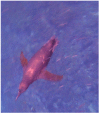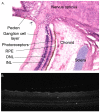An Overview of the Penguin Visual System
- PMID: 36810310
- PMCID: PMC9944954
- DOI: 10.3390/vision7010006
An Overview of the Penguin Visual System
Abstract
Penguins require vision that is adequate for both subaerial and submarine environments under a wide range of illumination. Here we provide a structured overview of what is known about their visual system with an emphasis on how and how well they achieve these goals. Amphibious vision is facilitated by a relatively flat cornea, the power in air varying from 10.2 dioptres (D) to 41.3 D depending on the species, and there is good evidence for emmetropia both above and below water. All penguins are trichromats with loss of rhodopsin 2, a nocturnal feature, but only deeper diving penguins have been noted to have pale oil droplets and a preponderance of rods. Conversely, the diurnal, shallow-diving little penguin has a higher ganglion cell density (28,867 cells/mm2) and f-number (3.5) than those that operate in dimmer light. In most species studied, there is some binocular overlap, but this reduces upon submergence. However, gaps in our knowledge remain, particularly with regard to the mechanism of accommodation, spectral transmission, behavioural measurements of visual function in low light, and neural adaptations to low light. The rarer species also deserve more attention.
Keywords: Spheniscidae; accommodation; amphibious; bird; eye; eyesight; nocturnal; underwater; vision.
Conflict of interest statement
The authors declare no conflict of interest.
Figures











Similar articles
-
Selected ocular dimensions of three penguin species.Vision Res. 2022 Dec;201:108122. doi: 10.1016/j.visres.2022.108122. Epub 2022 Sep 21. Vision Res. 2022. PMID: 36152389
-
Retinal ganglion cell topography and spatial resolving power in penguins.Brain Behav Evol. 2012;80(4):254-68. doi: 10.1159/000341901. Epub 2012 Oct 2. Brain Behav Evol. 2012. PMID: 23038153
-
Penguin lungs and air sacs: implications for baroprotection, oxygen stores and buoyancy.J Exp Biol. 2015 Mar;218(Pt 5):720-30. doi: 10.1242/jeb.113647. J Exp Biol. 2015. PMID: 25740902
-
Visual adaptations of diurnal and nocturnal raptors.Semin Cell Dev Biol. 2020 Oct;106:116-126. doi: 10.1016/j.semcdb.2020.05.004. Epub 2020 Jul 10. Semin Cell Dev Biol. 2020. PMID: 32654971 Review.
-
From optics to attention: visual perception in barn owls.J Comp Physiol A Neuroethol Sens Neural Behav Physiol. 2011 Nov;197(11):1031-42. doi: 10.1007/s00359-011-0664-3. Epub 2011 Jul 7. J Comp Physiol A Neuroethol Sens Neural Behav Physiol. 2011. PMID: 21735223 Review.
References
-
- Martin G.R. The Sensory Ecology of Bird. Oxford University Press; Oxford, UK: 2017. pp. 27, 49–55, 122, 125, 191–196, 259–296.
-
- Cobb S. The size of the olfactory bulb in 108 species of birds. Auk. 1968;85:55–61. doi: 10.2307/4083624. - DOI
-
- First Penguin in New Zealand to Undergo Cataract Surgery Makes Full Recovery. [(accessed on 30 October 2022)]. Available online: https://www.stuff.co.nz/national/health/129758464/first-penguin-in-new-z....
Publication types
LinkOut - more resources
Full Text Sources

